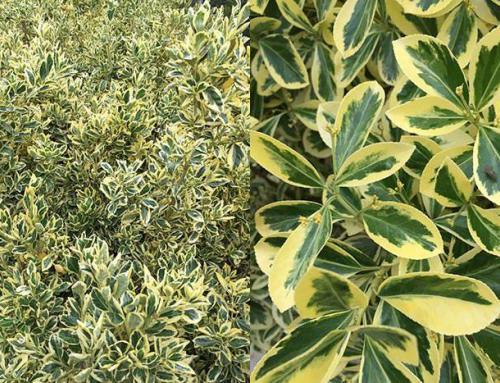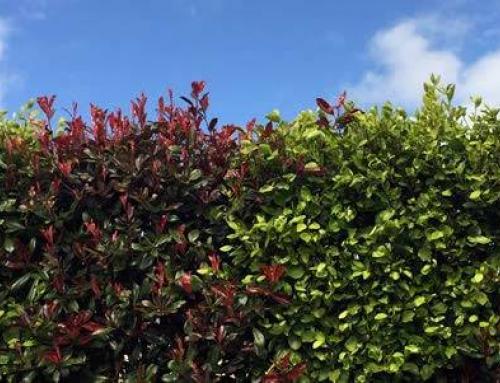Ilex or the Holly family of plants is familiar to most of us – perhaps most notably in winter when this iconic evergreen shrub with deep green, glossy leaves is covered in visually contrasting blood red berries. However there are so many holly varieties with all kinds of foliage colour. And Ilex comes in all shapes and sizes. Whatever your favourite, these gorgeous evergreen plants offer both ornamental interest in the garden and sustenance for wildlife.
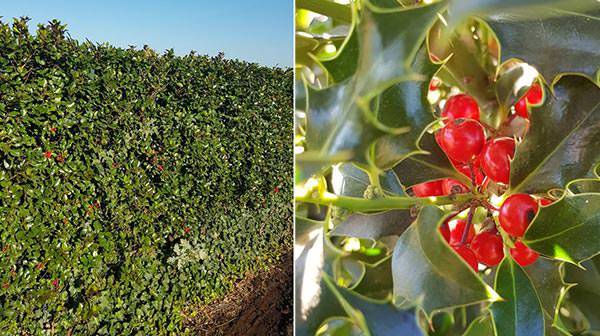
Whether grown as a hedge or a standalone shrub, Holly is always impressive. (Left: Common Holly, right: Ilex A. Alaska)
Ilex or Holly is a large family of plants with many varieties, which can be male or female. It is an ancinet plant with a fascinating history throughout the world. From our own native English holly Ilex Aquifolium to the small-leaved Japanese Holly Ilex Crenata there are countless beautiful Hollies to consider when seeking the perfect match for your own garden, from the stunning variegated hollies to topiary Hollies and Ilex Crenata Cloud trees.
Before we take a deeper look into the Holly varieties, let’s see why Hollies hold such a special place in the world of evergreens.
The Symbolism of the Holly Through History
While most of us in Britain will be familiar with holly as a Christmas decoration, Hollies also play an important role in the folklore of many cultures.
In ancient Rome, Holly was considered sacral, and Ilex twigs were placed on doors to ward off evil. Additionally, Hollies were grown near a home as it was believed this would keep its inhabitants safe from witchcraft and lightning strikes.
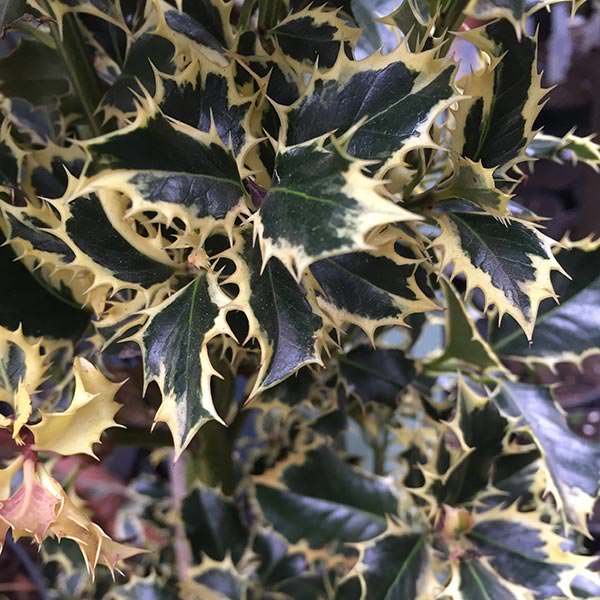
Common Holly with variegated foliage brings a welcome twist to a well-loved classic.
Similarly, in the British Isles, our native Ilex Aquifolium was held in high esteem by the ancient druids. The berry-producing shrub was credited with protective abilities and represented fertility and eternal life.
But the most widely recognisable symbolism for this shrub is of Christian origin. The thorny boughs of the evergreen shrub represent the crown of thorns which Jesus Christ wore before he died and the vivid crimson berries stand in place of drops of blood. In fact, the German word for Holly is “christdorn” which means Christ’s thorn. Nowadays, Hollies are still widely used as Christmas ornamental plants, from beautiful wreaths to boughs to accompany decorated Douglas firs.
Ilex Family of Plants: Best Holly Varieties
Ilex, or Holly, is a large family of (mainly evergreen) plants that includes 400 to 600 separate species. Needless to say, Ilex shrubs come in various shapes and sizes – offering something for everyone!
What is common for the majority of Hollies is that the individual plants are either male or female; meaning that you will need one of each plant in the near vicinity for the shrub to produce the red berries. Additionally, while the berries might be toxic to humans, wildlife thrives on them. Overwintering birds such as robins, chaffinches, bramblings, and others, absolutely adore these juicy crimson berries.
Here at Paramount Plants and Gardens, we offer a selection of Holly varieties. In addition to this, our hollies come in many shapes and sizes. Hollies for growing as stand-alone bushes are a given. But we also offer hollies for hedging. Holly Trees can be pleached Ilex trees or standard holly trees. We also have holly topiary Here are our best selling Holly varieties:
Ilex Aquifolium (Common or Native Holly)
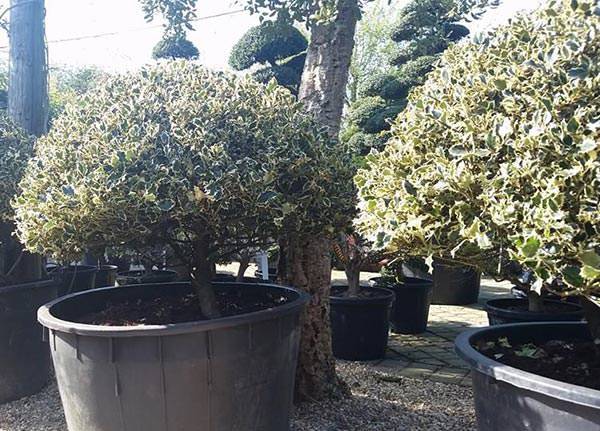
This mushroom-shaped holly variety is ideal for growing in pots near a patio for a year-round interest.
The easily recognisable English Holly lends itself well to a variety of roles in the garden. Slow growing and resilient, it is ideally suited for hedging or as a windbreak in coastal gardens. If you want to grow common Holly with a twist, choose the compact, mushroom-shaped Ilex Aquifolium Argentea Marginata that flaunts variegated foliage – it is also available in a topiary form.
Other popular choices include the conical Ilex Nellie Stevens (also available as a pleached tree and topiary tree form) and the striking and self-pollinating lIex Aquifolium Alaska.
Ilex Meserveae (Blue Holly)
Best known for their dark, waxy blue-green leaves, the Blue Hollies leave no one indifferent. They are perfect for mixed shrub borders where they offer multiple seasons of interest or planted en masse for hedging. Combine a male variety such as the Ilex Meserveae Heckenpracht or Blue Prince (available as a topiary globe) with one of the many female shrubs. Some favourites include Blue Angel (available as topiary), Blue Princess, or Blue Maid.
Ilex Crenata (Japanese Holly)
This species of Ilex native to Asia is best known for its dense, evergreen foliage comprised of tiny leaves. It is also known as box-leaved Holly, as it has leaves similar to those of Buxus. Because of this, Japanese Holly is most often used in hedging or trained as a topiary. At Paramount Plants and Gardens, we offer Ilex Crenata in all shapes and sizes: from pleached and Niwaki trees to lollipops, balls and spirals.
Ilex Koehneana (Chestnut Leaf Holly)
Grown as a pleached tree, this female Holly variety stands out for its large, chestnut-like leaves. If you want a highly-decorative variety that produces abundant crops of vermilion berries that will keep overwintering birds in your garden well fed, choose Ilex Koehneana. Just make sure to plant one of the male Hollies in its near vicinity!
Ilex Altaclerensis (Highclere Hollies)
This attractive hybrid originates from England. Its large and almost spineless leaves, as well as its imposing size, make Ilex Altaclerensis a welcome addition to spacious gardens.
Tips for UK Gardeners- How to Grow and Care for Hollies
Even though this gorgeous evergreen shrub offers year-round interest, it is not overly demanding. Most Hollies are fully hardy in the United Kingdom, and will not need any additional sheltering during cold winters. Choose a spot in full sun for optimal results, and well-drained, loamy soil.
When it comes to pruning Hollies, a lot will depend on the specific cultivar you have. For instance, Japanese Holly, especially those trained as topiary or cloud trees, do well with the occasional trimming and shaping. On the other hand, standard bushy Hollies need thinning from time to time – removing straggly, congested shoots will prevent disease and make for a prettier plant. Overall, caring for Ilex varieties is not complicated or time-consuming.

